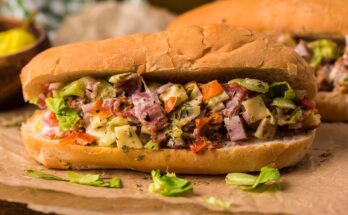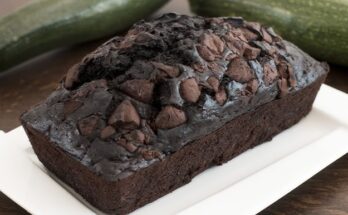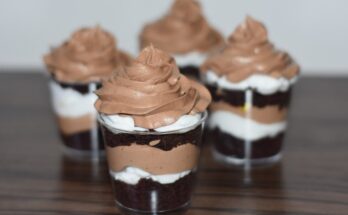Shrimp Pasta Recipe: Shrimp pasta hits all the right notes—it’s savory, rich, and has that gourmet feel with very little hassle. What really makes shrimp pasta so universally loved is its versatility. You can make it spicy, garlicky, creamy, or lemony, depending on your mood and the ingredients you have on hand. Plus, shrimp cooks super quickly, so you can whip this dish together in under 30 minutes without sacrificing flavor.
Another reason why it’s a go-to favorite? It looks impressive. Picture a glossy pile of linguine tangled up with plump, pink shrimp, all coated in a luscious garlic cream sauce—mouthwatering, right? Whether you’re feeding picky eaters or seasoned foodies, shrimp pasta always delivers.
Perfect Occasions to Serve Shrimp Pasta
Shrimp pasta is incredibly flexible when it comes to timing. Need a fast dinner after work? It’s done in a flash. Hosting friends or a romantic date night? This dish will wow your guests without breaking a sweat. It also makes a great centerpiece for weekend dinners or family gatherings. Just pair it with some crusty bread, a fresh salad, and a chilled glass of white wine—chef’s kiss.
Ingredients Needed for Shrimp Pasta
Main Ingredients
Let’s break down the must-haves for a classic shrimp pasta recipe:
- Shrimp: Fresh or frozen, peeled and deveined. Go for medium to large shrimp for the best texture.
- Pasta: Linguine or fettuccine works best, but feel free to experiment.
- Garlic: A lot of it—minced finely to flavor the sauce.
- Heavy Cream: This forms the base of your luscious sauce.
- Butter & Olive Oil: Adds depth and silkiness.
- Parmesan Cheese: Freshly grated for that rich, nutty taste.
- Salt & Pepper: Season generously.
- Red Pepper Flakes: Optional, but adds a nice kick.
- Fresh Parsley: For garnish and a fresh finish.
Optional Add-ons for Extra Flavor
Want to take it up a notch? Add these:
- White Wine: A splash enhances the sauce.
- Lemon Zest or Juice: Adds brightness.
- Spinach or Cherry Tomatoes: For color and freshness.
- Mushrooms or Bell Peppers: Adds body and texture.
These optional ingredients allow you to customize your shrimp pasta to fit your flavor profile and make it uniquely yours.
Prepping Your Ingredients
Cleaning and Deveining the Shrimp
If you bought fresh shrimp, cleaning them properly is a must. Start by removing the shell, leaving the tail on for presentation if you like. Next, use a paring knife to make a shallow cut along the back and pull out the dark vein. Rinse the shrimp under cold water, then pat them dry with paper towels.
Pro tip: Drying your shrimp ensures they sear nicely instead of steaming in the pan.
If you’re using frozen shrimp, thaw them overnight in the fridge or under cool running water for about 15-20 minutes. Make sure they’re fully thawed and dry before cooking.
Chopping and Preparing Fresh Produce
Now onto the flavor builders—garlic, parsley, maybe a squeeze of lemon or chopped tomatoes. Mince your garlic cloves finely (you’ll want at least 4-5 cloves), chop the parsley, and get your other veggies ready. Pre-grate the Parmesan cheese so it’s ready when you need to toss it in.
Doing all the prep work upfront means the actual cooking will be smooth and stress-free. Think of this as your “mise en place” moment, just like chefs do.
Cooking the Shrimp Pasta Step-by-Step
Step 1: Boiling the Pasta
Start by bringing a large pot of salted water to a boil. Once it’s rolling, add your pasta and cook until just al dente—you want it to have a little bite since it’ll finish cooking in the sauce. Drain and reserve about a cup of the pasta water. This starchy liquid will help your sauce stick to the pasta later on.
Don’t rinse the pasta; that starch on the surface is gold for creating a silky sauce that clings to every strand.
Step 2: Cooking the Shrimp to Perfection
Heat a mix of olive oil and butter in a large skillet over medium-high heat. Add the shrimp in a single layer and season with salt and pepper. Let them cook for about 1-2 minutes per side, until they turn pink and curl slightly. Be careful not to overcook them—shrimp can go from juicy to rubbery real quick.
Once cooked, transfer them to a plate and set aside. You’ll add them back to the sauce later.
Step 3: Creating the Creamy Garlic Sauce
Using the same pan, reduce the heat to medium. Add more butter if needed and toss in your minced garlic. Let it sizzle until fragrant, about 1 minute. If you’re using white wine, splash it in now and let it simmer for a couple of minutes to burn off the alcohol.
Next, pour in the heavy cream and stir gently. Let the sauce simmer and thicken slightly—this takes around 5 minutes. Once it starts to thicken, add grated Parmesan cheese gradually, stirring until it melts into a velvety, cheesy sauce.
If it’s too thick, just stir in a bit of the reserved pasta water until you get your desired consistency.
Step 4: Combining All the Components
Time to bring it all together. Toss in the cooked pasta and gently fold it into the sauce until well coated. Return the shrimp to the skillet, along with any juices that collected on the plate.
Finish off with chopped parsley, an extra sprinkle of Parmesan, and red pepper flakes if you like heat. Give everything a good toss, taste, and adjust the seasoning if needed.
Serve hot, preferably with some toasted garlic bread on the side.
Tips and Tricks for the Best Shrimp Pasta
How to Avoid Overcooking Shrimp
Let’s face it—overcooked shrimp is a tragedy. It goes from juicy and tender to rubbery and dry in a flash. To avoid this, timing is everything. Shrimp only needs about 1 to 2 minutes per side on a hot skillet. As soon as it turns opaque and curls slightly into a “C” shape, it’s done.
Another great tip? Cook your shrimp in batches if you’re using a smaller pan. Crowding the pan causes the shrimp to steam instead of sear, and that’s not what we want here. You’re looking for a light golden sear for maximum flavor and texture.
Lastly, if your sauce needs more cooking time, don’t leave the shrimp in there too long. Add them back in right at the end, just to warm through. They’ll soak up all the flavor without overcooking.
Choosing the Right Pasta Type
Not all pasta is created equal—especially when it comes to shrimp pasta. While you can technically use any pasta you like, some types just work better. Here’s a quick guide:
- Linguine or Fettuccine: Ideal for creamy sauces. Their wide surface area allows the sauce to cling beautifully.
- Spaghetti: A classic choice, but it doesn’t hold as much sauce. Still delicious, though.
- Penne or Rigatoni: Great if you want a more rustic feel with a chunkier sauce.
- Angel Hair: Super delicate, so it can easily get mushy if overcooked. Use with lighter sauces.
Gluten-free? No problem. There are amazing alternatives made from rice, lentils, or chickpeas that work just as well.
The key is to cook the pasta al dente and toss it into the sauce while it’s still hot. This helps the pasta absorb all those delicious flavors, making every bite more satisfying.
Making It a Complete Meal
Pairing Sides with Shrimp Pasta
You’ve got this creamy, dreamy shrimp pasta—now what? Let’s build out the meal. Here are some perfect side dishes that complement it without overpowering it:
- Garlic Bread or Baguette: Nothing beats swiping a slice through the leftover sauce.
- Mixed Green Salad: Add some brightness with arugula, spinach, or spring mix, tossed in a light vinaigrette.
- Roasted Veggies: Think asparagus, zucchini, or broccoli for extra nutrition.
- Grilled Lemon or Citrus Veggies: Brings a refreshing contrast to the richness of the sauce.
These sides help balance the richness of the pasta while also making the meal feel more complete and well-thought-out.
Wine Pairings for an Elegant Touch
If you want to elevate your shrimp pasta dinner, wine is your best friend. Here are some pairings that will bring out the best in the dish:
- Chardonnay: Creamy, buttery, and rich—perfect for creamy garlic shrimp pasta.
- Sauvignon Blanc: Crisp and citrusy, great if your pasta has lemon or tomatoes.
- Pinot Grigio: Light and neutral, lets the dish shine.
- Sparkling Wine: Fun, festive, and surprisingly good with shrimp.
Serving wine? Chill it slightly and pour into tall glasses. You’ll instantly feel like you’re dining in a classy bistro.
Storing and Reheating Leftovers
Best Practices for Refrigerating
Shrimp pasta stores surprisingly well, but there are a few things to keep in mind. First, let it cool completely before storing. Transfer to an airtight container and refrigerate. It will last up to 3 days in the fridge.
Since seafood can be delicate, don’t wait too long to eat your leftovers. Also, if you’re meal prepping, consider storing the shrimp and pasta separately to keep the textures just right when reheating.
How to Reheat Without Losing Flavor
To reheat, skip the microwave if you can. Instead, use a non-stick skillet over low heat. Add a splash of milk or cream to revive the sauce and prevent it from drying out. Toss the pasta gently until heated through.
If you must use the microwave, add a spoonful of water or cream and cover the container with a microwave-safe lid. Heat in 30-second intervals, stirring in between.
Avoid overcooking the shrimp during reheating—it’s already cooked, so you just need to warm it up. A little patience goes a long way here.
Creative Variations of Shrimp Pasta
Spicy Shrimp Pasta for Heat Lovers
Love spice? Crank up the heat with these variations:
- Add Extra Red Pepper Flakes: Start with ½ teaspoon and go from there.
- Spicy Cajun Shrimp Pasta: Toss the shrimp in Cajun seasoning before cooking. Add bell peppers and onions for that southern-style kick.
- Creamy Chipotle Sauce: Blend a chipotle pepper with the cream base for smoky, spicy depth.
These versions bring a whole new layer of flavor and excitement to the dish.
Lemon-Garlic Shrimp Pasta for a Lighter Twist
If you prefer something zesty and fresh, this variation is your best bet. Swap the cream for a light olive oil and lemon juice combo. Add lots of fresh parsley and garlic, and toss with angel hair pasta. It’s light, fragrant, and perfect for summer evenings.
Want to make it healthier? Use whole wheat pasta and add greens like spinach or kale. It’s still packed with flavor but way easier on the waistline.
Making Shrimp Pasta Kid-Friendly
How to Tone Down Spices for Kids
Cooking for picky eaters or little ones? Shrimp pasta can still be a hit—you just need to make a few adjustments. Start by dialing down the spice. Skip the red pepper flakes and strong seasonings like Cajun or chipotle. Instead, stick with simple ingredients: butter, garlic, a splash of cream, and a sprinkle of Parmesan.
You can also add a touch of sweetness by roasting cherry tomatoes and folding them into the pasta. Their natural sugars caramelize during roasting, which helps mellow out the dish and make it more kid-friendly.
Want to get your kids involved? Let them help with the pasta or sprinkle the cheese. It turns dinner into an experience and gets them excited about trying something new.
Adding Hidden Veggies for Nutrition
Shrimp pasta is a sneaky and smart way to get more veggies into your kid’s diet. Blend cooked carrots, zucchini, or even cauliflower into the sauce for a boost of nutrients without sacrificing taste. Once mixed in, the veggies practically disappear, flavor-wise.
Spinach is another easy addition. Stir it into the sauce just before combining with the pasta—it wilts instantly and adds a pop of color and health. Or toss in peas or finely chopped broccoli if your kids are okay with seeing the greens.
Making it healthier while keeping it delicious? That’s a parenting win.
Gluten-Free and Dairy-Free Options
Substituting Pasta and Cream Ingredients
Gluten or dairy restrictions? No problem—shrimp pasta can easily be adapted.
For gluten-free diets:
- Use gluten-free pasta varieties like rice, corn, chickpea, or quinoa pasta.
- Make sure your Parmesan and seasonings are certified gluten-free.
For dairy-free diets:
- Swap the cream with unsweetened coconut milk, cashew cream, or almond milk with a touch of flour or starch to thicken.
- Nutritional yeast is a great alternative to Parmesan—it gives a cheesy flavor without the dairy.
- Use olive oil instead of butter for the sauce base.
Just be sure to season well. Without the richness of dairy, you’ll want bold flavors from garlic, herbs, and maybe a squeeze of lemon to keep things exciting.
Flavorful Alternatives That Work
Some dairy-free sauces that still bring the flavor:
- Lemon-Garlic Olive Oil Sauce: Bright, simple, and full of zing.
- Roasted Red Pepper Sauce: Blend roasted peppers with garlic and olive oil for a bold, creamy base.
- Avocado Cream Sauce: Smooth, green, and surprisingly delicious on pasta with shrimp.
So yes—you can make this dish friendly for everyone without giving up the comfort or taste.
Freezing and Meal Prep Tips
Can You Freeze Shrimp Pasta?
Yes, but with a few caveats. Pasta dishes with cream sauce don’t always freeze beautifully. The sauce can sometimes separate when thawed. However, if you must freeze it:
- Cool the shrimp pasta completely.
- Store in an airtight, freezer-safe container.
- Try to eat it within 2-3 weeks for best taste.
To help prevent the sauce from breaking, consider undercooking the pasta slightly and adding a splash of cream or milk during reheating.
Best Containers and Storage Techniques
Use portion-sized containers if you’re meal-prepping for the week. This way, you only reheat what you need without wasting any leftovers.
Vacuum-sealed bags also work great if you’re freezing larger batches. Just lay them flat in the freezer for easier storage. Label everything with the date to keep track.
When you’re ready to reheat, thaw in the fridge overnight and then gently warm it on the stove with added liquid for a creamy revival.
Common Mistakes to Avoid
Overcooking the Pasta or Shrimp
We’ve said it before, but it bears repeating: timing is key. Overcooked shrimp becomes rubbery, and mushy pasta ruins the texture of the dish. Set timers and test frequently. Pull the pasta when it still has some bite (al dente) and only cook the shrimp until pink.
Remember—both continue cooking even after you remove them from heat, especially when mixed with the hot sauce and pasta.
Using Low-Quality Ingredients
Since shrimp pasta is a simple dish, quality makes a big difference. Use fresh garlic, good olive oil, and real Parmesan—not the powdered kind. If you can get fresh or wild-caught shrimp, even better. And don’t skimp on herbs—fresh parsley or basil elevates the dish from good to unforgettable.
You don’t need fancy ingredients—just fresh, flavorful ones that let each component shine.
FAQs about Shrimp Pasta Recipe
1. What type of pasta is best for shrimp pasta?
For shrimp pasta, linguine and spaghetti are popular choices because their long, slender shape pairs well with the delicate texture of shrimp. However, feel free to experiment with other types like penne or fusilli, which are great at holding onto sauces.
2. Can I use frozen shrimp for this recipe?
Absolutely! Frozen shrimp can be a convenient and budget-friendly option for making shrimp pasta. Just ensure you thaw them properly by placing them in the refrigerator overnight or in a bowl of cold water for about 15 to 20 minutes before cooking.
3. What ingredients are essential for a flavorful shrimp pasta?
Aromatic ingredients like garlic, onion, and fresh herbs such as parsley or basil are key to enhancing the flavor of shrimp pasta. Adding a splash of white wine can also elevate the taste, along with staples like olive oil, salt, and pepper.
4. How do I prevent the shrimp from overcooking?
Shrimp cook very quickly, so it’s crucial to add them to the pasta at the right time. Cook them until they are pink and slightly firm to the touch, which usually takes about 2-3 minutes. Overcooked shrimp can become tough and rubbery, so keep an eye on the clock!
5. Are there any good dairy-free alternatives for creamy shrimp pasta?
For those avoiding dairy, coconut milk and cashew cream are excellent substitutes for cream in a pasta sauce. They offer a rich, creamy texture without the use of traditional dairy products.
6. How can I make my shrimp pasta a bit healthier?
Opt for whole grain or whole wheat pasta to increase the fiber content of your dish. You can also load up on vegetables like spinach, tomatoes, and bell peppers to add nutrients and color to your pasta.
7. What side dishes pair well with shrimp pasta?
A simple green salad dressed with lemon vinaigrette or a side of garlic bread complements shrimp pasta wonderfully. They provide a nice balance to the dish’s richness and help round out the meal.
Conclusion
Shrimp pasta is one of those dishes that feels fancy but is secretly simple to make. With just a few fresh ingredients, a good skillet, and a solid plan, you can whip up a meal that impresses anyone—from your picky kids to a date-night guest. The beauty lies in its versatility—creamy, spicy, lemony, or dairy-free, you can tailor it to fit your cravings or dietary needs.
So next time you want something quick, comforting, and undeniably delicious, you know what to cook. Give this shrimp pasta recipe a try and make it your own. You might just find it becoming a new favorite in your kitchen rotation.



